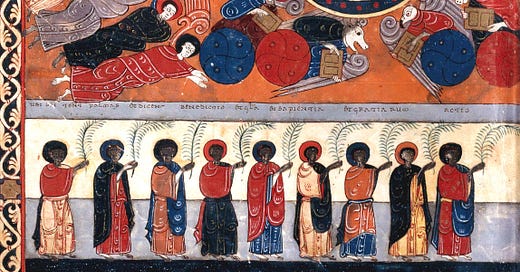The Sixth Seal, the last persecution: Reading Beatus of Liébana
A Visigoth monk tells us about the end of the world
Reading Beatus with the eyes of the 1047 Codex
The four living creatures and the twenty-four elders fell down before the Lamb, each having a harp, and golden bowls full of incense, which are the prayers of the saints. And they sang a new song, saying:
“You are worthy to take the scroll,
And to open its seals;
For You were slain,
And have redeemed us to God by Your blood
Out of every tribe and tongue and people and nation,
And have made us kings and priests to our God;
And we shall reign on the earth.”
Since looking more closely on Thursday at the story of the founding of the Kingdom of Asturias, and the development of its singular Christian artistic forms, I can’t seem to leave these incredible Beatus manuscripts. I found myself scrolling through the images from the 1047 edition of St.Beatus’1 Commentary on the Apocalypse. They really are unlike anything else in Christian art. Full of force, with blazing colours and figures so stylised they are almost grotesques.
There’s something in them that resists being merely looked at; they have about them a sense of urgency that I seem to have picked up. I wanted to know what words could possibly go with these burning visions that have captivated for so long.
In this monk’s world, people were also living in turbulent, uncertain times. They feared the collapse of Christendom and its overrunning by aggressive foreign forces holding an alien creed. They had watched that occupying force descend on their land, imposing false teachings, demanding they abandon the worship of Christ. They also wondered if they were living in the last days.
So I bought the Kindle edition of a modern English translation of the text and am reading it slowly. St. Beatus’ commentary was so celebrated that at least 27 hand copied and illustrated editions were produced, and for hundreds of years after his death, up to the 13th century. His commentary is indeed just as strange and riveting as the images; layered, allegorical and alive with a sense of spiritual urgency. And far from being remote, much of it seems extremely pertinent for our own times.
So my dive into these pages feels a bit of a strange journey. But I think it’s one of those things you have to stick with, and not rush through. And if you let the images speak in their own language you can begin to feel something open in yourself.
For those who have always wondered what the Book of Revelation means, but have never gone deep into its labyrinth of signs and symbols; for those who feel, perhaps, that here in the 21st century we might finally be seeing the times it foretells, I thought a post investigating directly from the text might be of value.
I’ve paired one of the most compelling illuminations from the 1047 “Facundus” copy with translated excerpts of the corresponding text. I’m so fascinated by this challenging process that we’ll have to come back to it. There’s only so much space for these faceted and layered details in a blog post, even for our very patient and committed paying subscribers.
But I’d suggest reading the following slowly and carefully, maybe cross referencing with a good Patristic commentary bible at your elbow, as I’m doing. And be warned; some of it is a bit chilling if you follow the news at all.
I hope you’ll join us as we dig deeper into these mysteries.





